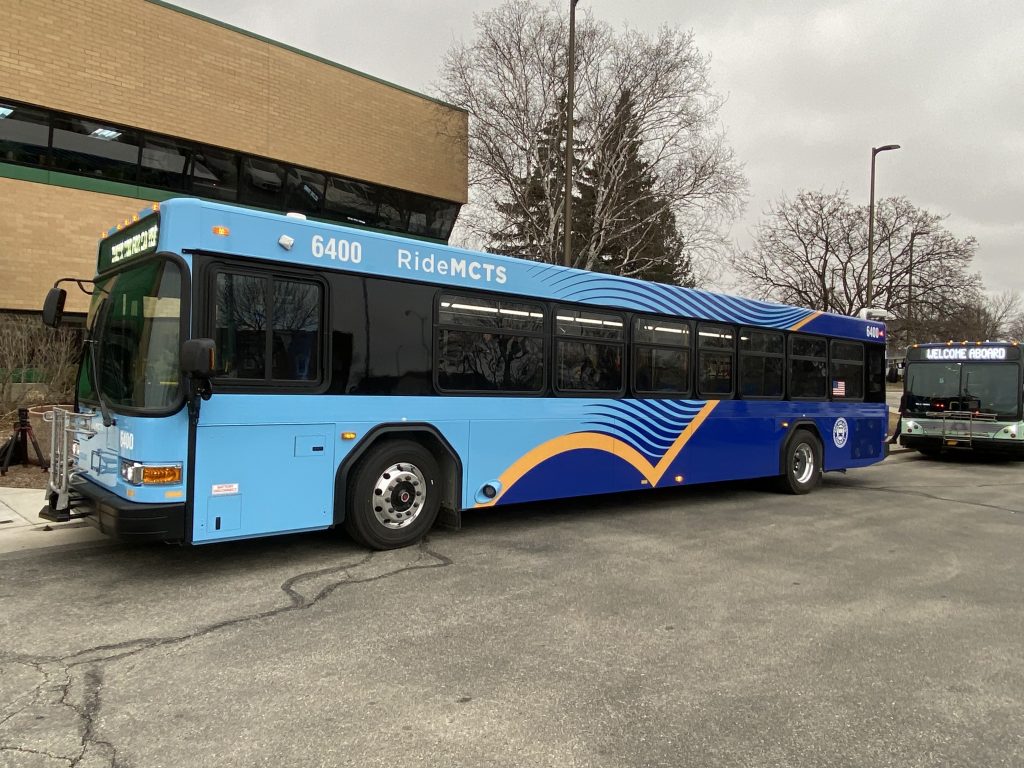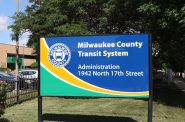MCTS Plans 15% Service Cut
Budget issues yield more frequency reductions, elimination of same-day paratransit service.

MCTS Gillig bus. Photo by taken March 19, 2025 by Graham Kilmer.
The Milwaukee County Transit System (MCTS) is planning major changes next year with a 15% cut to service. In addition to eliminating six routes, the system will likely cut an on-demand car service for persons with disabilities and slow bus frequency on 22 routes.
In September, Milwaukee County Executive David Crowley released his proposed 2026 budget. It included cuts to bus service and an increase in bus fares from $2 to $2.75 and daily cap from $5 to $8.25 to close a $14 million gap in the MCTS budget.
During a budget meeting with the Milwaukee County Board’s Committee on Finance Monday, MCTS announced plans to cut an on-demand paratransit ride service. The program was created as a pilot in 2024 with a $1.2 million budget. MCTS contracted with Via, a New York-based transportation company, to provide on-demand rides with wheelchair accessible vehicles. The county subsidized approximately 90% of the cost of the service, and riders paid a $10 fare. It would cost $1.9 million to continue the program next year, according to MCTS.
“We would love to continue the same-day pilot program. However, given our financial constraints, we had to make very hard decisions maintaining that service,” said MCTS President and CEO Steve Fuentes. Maintaining the service would require deeper cuts to bus service, he said.
TransitPlus, the name of MCTS’ paratransit system, requires passengers to schedule rides 24 hours ahead. The same-day, on-demand service was created to provide rides for unexpected trips. It replaced a taxi service that fell out of compliance with federal regulations. Sandy Kellner, MCTS chief administrative officer, said the system would continue to work with paratransit advocates to find a solution to same-day paratransit needs.
MCTS plans to cut six routes and shorten five routes to help balance the budget next year. During the budget meeting Monday, MCTS also announced it was increasing the number of routes that would have bus frequency lowered. In total, 22 routes would see the frequency of bus service reduced in 2026.
In 2021, MCTS redesigned its system to favor high-frequency routes. The routes are the system’s “bread and butter” and account for a majority of ridership, or more than 70%, according to Jesus Ochoa, MCTS director of service development. The routes targeted for cuts are the system’s lowest ridership routes.
Though low ridership does not mean no ridership. Supervisor Justin Bielinski announced during the meeting that he plans to seek funding to save Route 28, which runs through his district in West Allis. Route 28 sees approximately 890 riders per day during weekdays. Sup. Sequanna Taylor said 890 riders per day didn’t sound low to her. Ochoa noted that Route 30, the most heavily used route in the system, sees approximately 8,500 riders per day.
Sup. Shawn Rolland questioned how MCTS was evaluating the second-order impacts of the cuts, like overloaded buses, as ridership is pushed to other routes.
The system should be able to react quickly to any service challenges that occur as a result of the cuts, Fuentes said.
“And what we’re going to do is, once the final budget is adopted and we know exactly what routes are going to be eliminated, modified or reduced frequency, we’re going to watch those numbers,” he said. “And if we are seeing crush loads, we do have the ability to put some extra service out there.”
MCTS was forced to put together a “reactive budget” trying to balance ridership and revenue, Fuentes said.
“We had to react to a lot of stuff that happened over the summer, unfortunately, and we had to do it quickly,” he said. “I would love to put out a proactive budget that is much more in line with what is best for Milwaukee County. I didn’t have the time to do that for this particular budget season.”
Stimulus funding runs out
During the COVID-19 pandemic, MCTS received approximately $192 million in federal stimulus funding, to plug gaps in the system’s budget. The funds were expected to last into 2027, but an unexpected budget deficit in 2025 caused the system to spend down more stimulus funding than previously planned. MCTS is using all remaining funding to close the 2026 budget gap.
“The problems that we saw at MCTS over the summer with the projected $10.9 million budget deficit was not a problem of overspending. It was not a problem of employee salaries being too high or anything like that,” said Fuentes, who took over as president and CEO in August. “It was, the budget was overly optimistic that was put out last year by the former CFO and former leadership of MCTS.”
The budget gap was always looming. The system costs more to operate than MCTS receives in annual revenue from state, federal and local funding sources, as well as from fares. For more than a decade, state mass transit operating aids, which are the largest source of funding, have declined or been frozen. Meanwhile, annual inflation has raised the cost of operation.
Should county raise vehicle registration fee?
Sup. Rolland raised the prospect of increasing the county vehicle registration fee (VRF), often referred to as the wheel tax, to fund transit. The current VRF is $30 per vehicle and is projected to generate approximately $17 million in revenue in 2026.
“We’ve talked about how state support for public transit has been flat forever, and that continues to be an issue. I would also say that the wheel tax has been flat since 2017 and since then inflation has gone up by 32%,” Rolland said.
The supervisor suggested pegging VRF increases to the rate of inflation.
“Because if state support remains flat and county support doesn’t keep pace with inflation, we’re just as guilty as the state for not funding the bus system enough,” Rolland said.
Proposed 2026 frequency reductions
Monday through Friday – Routes 11, 12, 14, 22, 31, 51, 53, 57, 60, 63, 80, 88 and Connect 1
Saturday – Routes 11, 18, 19, 21, 24, 31, 59, 74, 80, 88, GreenLine, PurpleLine and RedLine
Sunday – Routes 11, 24, 31, 59, 74, 80 and 88.
If you think stories like this are important, become a member of Urban Milwaukee and help support real, independent journalism. Plus you get some cool added benefits.
More about the 2026 Milwaukee County Budget
- Transportation: MCTS Budget Picture Keeps Getting Worse - Graham Kilmer - Dec 4th, 2025
- Transportation: MCTS Avoids Full Route Cuts Under New Plan - Graham Kilmer - Nov 27th, 2025
- MKE County: Crowley Signs $1.3 Billion Budget Without Vetoes - Graham Kilmer - Nov 11th, 2025
- County Executive Crowley, Chairwoman Nicholson-Bovell Approve 2026 County Budget - David Crowley - Nov 7th, 2025
- MKE County: Board Adopts 2026 Budget, Reduces Size of MCTS Cut - Graham Kilmer - Nov 6th, 2025
- Supervisor Sequanna Taylor Highlights Key Co-Sponsorships in 2026 Milwaukee County Budget - Sequanna Taylor - Nov 6th, 2025
- Supervisor Martin Applauds Board Approval of Cooper Park Repair Amendment - Sup. Felesia Martin - Nov 6th, 2025
- Milwaukee County Board Advances Budget Amendments to Strengthen Transit, Health, Housing, and Family Well-Being While Reducing the Tax Levy - County Board Chairwoman Marcelia Nicholson - Nov 6th, 2025
- Milwaukee County Executive David Crowley Statement on 2026 Amended Budget - David Crowley - Nov 6th, 2025
- Transportation: Supervisors Use Parliamentary Moves To Save MCTS - Graham Kilmer - Oct 31st, 2025
Read more about 2026 Milwaukee County Budget here
MKE County
-
Detox Center, Eviction Lawyers, Student Aid Would Be Cut In 2026
 Oct 16th, 2025 by Graham Kilmer
Oct 16th, 2025 by Graham Kilmer
-
Despite Funding Increase, Sheriff Says Agency Is Left With Less
 Oct 16th, 2025 by Graham Kilmer
Oct 16th, 2025 by Graham Kilmer
-
Airport Forecasting No Passenger Growth in 2026
 Oct 15th, 2025 by Graham Kilmer
Oct 15th, 2025 by Graham Kilmer
Transportation
-
Construction Starting On $1.7 Billion Interstate 94 Widening
 Oct 15th, 2025 by Jeramey Jannene
Oct 15th, 2025 by Jeramey Jannene
-
Airport Forecasting No Passenger Growth in 2026
 Oct 15th, 2025 by Graham Kilmer
Oct 15th, 2025 by Graham Kilmer
-
Emails Reveal MCTS Officials Concealed Budget Deficit From Comptroller, County Board
 Oct 10th, 2025 by Graham Kilmer
Oct 10th, 2025 by Graham Kilmer





















I want to thank the incompetent, entitled culture management of MCTS, all the fare evaders, the County Board and the press who refuses to adequately cover the dysfunctional, management of MCTS for diminishing my quality of life.
I have been dependent on public transit my entire adult life. I am a working, taxpaying citizen who never evaded my fare and until recently would pay the fare of others. Thank you all for making me a second class citizen.
I think it’s time the National Guard get called in. An armed Guard on every bus to kick the fare evaders off the bus and force the operators to accept cash fare of those willing to pay it. (I recently saw an operator tell a person about to pay $2 cash fare he didn’t have to.) Corruption all around.
The only way for the country to achieve its Vision Zero goal is to reduce driving. It can do this by increasing the car registration fee and retaining/increasing public transit. Do we have the backbone to do it?